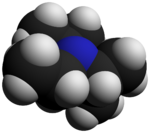N,N-Diisopropylethylamine
 |
|||
 |
|||
|
|
|||
| Names | |||
|---|---|---|---|
|
Preferred IUPAC name
N-Ethyl-N-(propan-2-yl)propan-2-amine
|
|||
Other names
|
|||
| Identifiers | |||
|
3D model (JSmol)
|
|||
| ChemSpider | |||
| ECHA InfoCard | 100.027.629 | ||
| EC Number | 230-392-0 | ||
| MeSH | N,N-diisopropylethylamine | ||
|
PubChem CID
|
|||
| UN number | 2733 | ||
|
|||
|
|||
| Properties | |||
| C8H19N | |||
| Molar mass | 129.25 g·mol−1 | ||
| Appearance | Colorless liquid | ||
| Odor | Fishy, ammoniacal | ||
| Density | 0.742 g mL−1 | ||
| Melting point | −50 to −46 °C (−58 to −51 °F; 223 to 227 K) | ||
| Boiling point | 126.6 °C; 259.8 °F; 399.7 K | ||
| 4.01 g/L (at 20 °C) | |||
| Vapor pressure | 4.1 kPa (at 37.70 °C) | ||
|
Refractive index (nD)
|
1.414 | ||
| Hazards | |||
| GHS pictograms |
  
|
||
| GHS signal word | DANGER | ||
| H225, H301, H314, H412 | |||
| P210, P273, P280, P301+310, P305+351+338, P310 | |||
| Flash point | 10 °C (50 °F; 283 K) | ||
| Explosive limits | 0.7–6.3% | ||
| Lethal dose or concentration (LD, LC): | |||
|
LD50 (median dose)
|
200–500 mg kg−1(oral, rat) | ||
| Related compounds | |||
|
Related amines
|
|||
|
Related compounds
|
|||
|
Except where otherwise noted, data are given for materials in their standard state (at 25 °C [77 °F], 100 kPa).
|
|||
|
|
|||
| Infobox references | |||
N,N-Diisopropylethylamine, or Hünig's base, DIPEA or DIEA, is an organic compound and an amine. It is used in organic chemistry as a base. Because the nitrogen atom is shielded by the two isopropyl groups and an ethyl group only a proton is small enough to easily fit. Like 2,2,6,6-tetramethylpiperidine, this compound is a good base but a poor nucleophile, which makes it a useful organic reagent. Hünig's base is named after the German chemist Siegfried Hünig. The compound is a colourless liquid.
Hünig's base is commercially available. It is traditionally prepared by the alkylation of diisopropylamine with diethyl sulfate. If necessary, the compound can be purified by distillation from potassium hydroxide.
Hünig's base was investigated for its use as a selective reagent in the alkylation of secondary amines to tertiary amines by alkyl halides. This organic reaction is often hampered by a quaternization reaction to the quaternary ammonium salt but this side-reaction is absent when Hünig's base is present.
Hünig's base forms a complex heterocyclic compound called scorpionine by a reaction with disulfur dichloride catalyzed by DABCO in a one-pot synthesis.
...
Wikipedia


